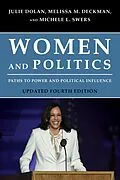Women and Politics: Paths to Power and Political Influence examines the role of women in politics from the early women's movements to the female politicians in power today. The revised fourth edition includes: a new preface analyzing the 2020 elections, focusing on the historic victory of Kamala Harris and the gendered and racist critiques she endured on the campaign trail.recognition of the centennial of women's suffrage, with greater attention to Black and Indigenous women's often overlooked contributions to the fight for suffrage and expanded rightselection results from the historic 2020 elections when more women filed congressional candidacies than ever before and women's numbers in both Congress and state legislatures reached record highs.analysis of the gender gap in voting in 2020, focusing on both race and gender.updates reflecting President Biden's historic cabinet picks, including Deb Haaland as the first Native American to lead the Department of the Interior and Janet Yellen as the first woman to lead the Treasury Department.coverage of the death of Supreme Court Justice Ruth Bader Ginsburg and the nomination and confirmation of her replacement, Amy Coney Barrett.
Autorentext
Julie Dolan is Professor of Political Science at Macalester College in St. Paul, Minnesota. She earned her PhD from American University. Her scholarly interests include American government and politics, women and politics, and bureaucratic politics. She has received a number of prestigious awards for her scholarship and publishes in a variety of journals including Women & Politics, Public Administration Review, PS: Political Science and Politics, the Journal of Public Administration Research and Theory. Her most recent research focuses on issues of political representation in the bureaucracy.
Melissa M. Deckman is the Louis L. Goldstein Professor of Public Affairs and Chair of the Political Science Department at Washington College. She earned her PhD from American University. Her areas of specialty include religion and politics, women and politics, and American political behavior, and she publishes in a variety of journals, including Journal of Women, Politics, and Public Policy, PS: Political Science and Politics, and American Politics Research, which most recently published her work (coauthored with John McTague) on the impact of the War on Women on the 2012 presidential election. Her forthcoming book, Mama Grizzlies and Politics, examines the role of women in the Tea Party in America.
Michele L. Swers is Professor of American Government in the Department of Government at Georgetown University. She earned her PhD from Harvard University. Her research and teaching interests encompass Congress, congressional elections, and women and politics. She has written two books on women and representation in Congress: The Difference Women Make: The Policy Impact of Women in Congress and Women in the Club: Gender and Policy Making in the Senate.
Inhalt
List of Figures and Tables ix
Preface: Updated 4th Edition xi
Acknowledgments xxxi
About the Authors xxxv
1 Introduction and Theoretical Framework 1
History and Women's Political Interests 3
Women's Representation 7
PART I: WOMEN'S PATHS TO POWER
2 Women's Paths to Power 13
Women in Social Movements and Interest Groups 13
Early Women Activists and the Fight For Suffrage 14
Feminism, the Second Wave (1960sPresent) 22
The Rebirth of the Feminist Movement 23
The Emergence of the Older and Younger Branches of the
Feminist Movement 25
The Equal Rights Amendment 32
Women and Interest Groups 37
Conservative Women's Groups Fight Back 42
Reinvigoration of the Feminist Movement and Conservative
Women's Activism 45
Conclusion 53
3 The Gender Gap in Elections and Public Opinion 55
Courting the Women's Vote: The Early Years 56
The Emergence of the Modern Gender Gap 59
The Gender Gaps: Voting Trends Across Different Groups of
Women 65
Issues That Explain the Gender Gap 68
Women's Vote in a Competitive Political Climate 72
Does the Gender Gap Bring Women Political Power? 83
Do Women Vote for Women? 86
Hillary Clinton and the Women's Vote 89
Conclusion 94
4 Gender and the Decision to Run for Office 97
A Confidence Gap: Women Underestimate Their Political Abilities 101
Political Parties' Efforts to Incorporate Women 105
Family Constraints 113
Symbolic Representation: Does It Matter Whether Women Run
for Office? 115
Conclusion 120
5 Women on the Campaign Trail 123
Challenges on the Campaign Trail 127
Voter Stereotypes about Female Candidates 128
Media Coverage of Female Candidates 135
Female Presidential and Vice Presidential Candidates 140
Navigating Gender on the Campaign Trail: The 2016 Elections 143
Conclusion 156
PART II: WOMEN IN POWER
6 Women in Local Politics and Government 159
Descriptive Representation: Women Serving in Local Government 163
The Numbers: Women as Mayors and Local Executives 165
The Numbers: Women on City and Council Councils 169
The Numbers: Women Serving as School Board Members,
Clerks, Sheriffs, and Other Local Officers 171
What Determines Women's Representation in Such Offices? 174
Local Office as Stepping-stones: Filling the Pipeline? 180
Substantive Representation: Does Having Women in Local
Government Matter? 181
Women as Political Actors Outside of Government 188
Conclusion 194
7 Wom...
